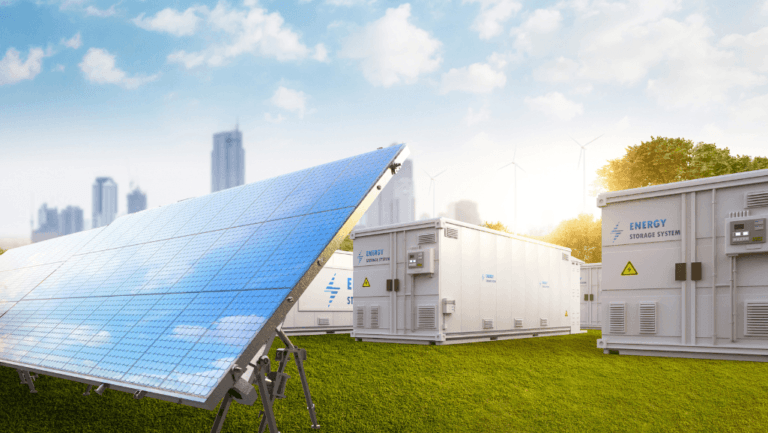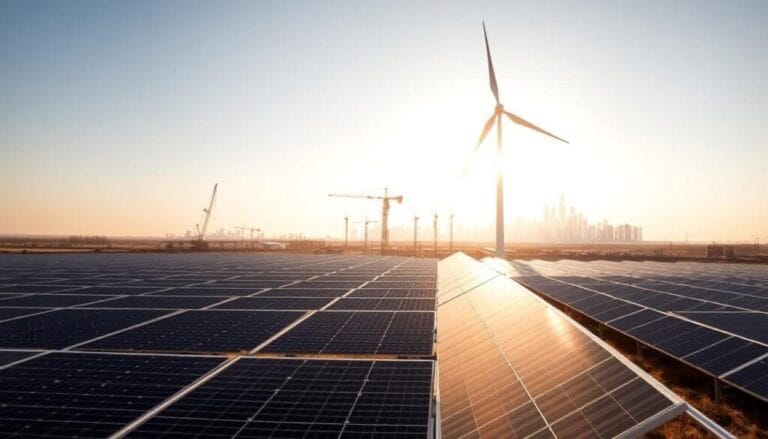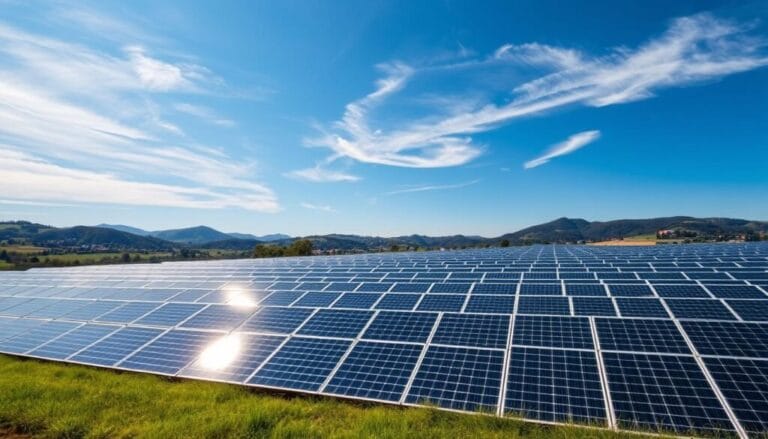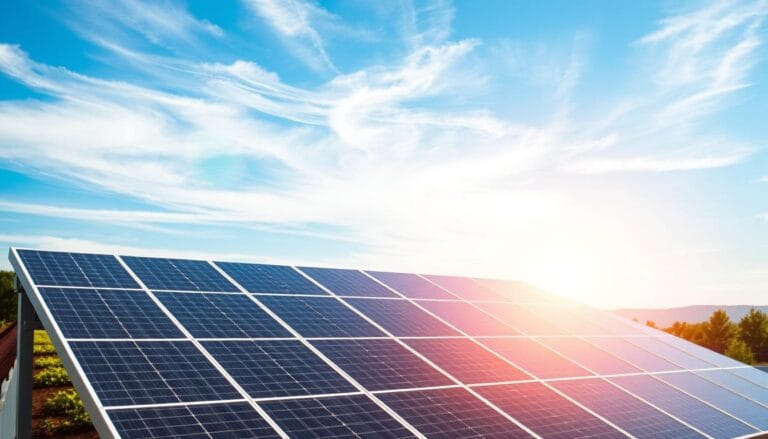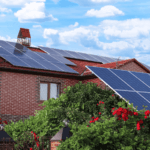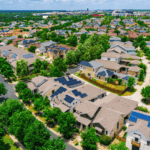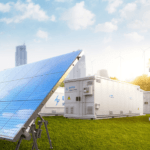Switching to solar energy is a smart move for homeowners today. The best solar panel cost is now more affordable. A typical 10.8 kW solar setup, enough for most American homes, could be as low as $20,948 after tax credits. This makes solar power a great investment for the future.
The initial cost of solar panels is lowered by a 30% federal tax credit. This makes solar energy more accessible to many people. However, costs can vary by region. For example, prices differ from sunny California to Massachusetts, showing the importance of getting a detailed cost estimate.
Switching to solar can save homeowners between $28,000 and $120,000 over 25 years. On average, it pays off in about 7.5 years. With prices dropping by 50% since 2010, solar power is becoming increasingly popular.
Key Takeaways
- Federal tax credits reduce solar panel system costs, making solar energy more attractive and affordable for homeowners.
- Differences in state incentives and local climate conditions are crucial when estimating the solar panel installation cost for a home.
* The average solar panel price per watt stands approximately at $2.75 before incentives, with significant potential savings in the long run.
- Variability in solar equipment and installation costs makes personalized estimates crucial for accurate budgeting.
- Investing in solar energy could lead to savings of up to $120,000 over 25 years, underscoring the value of solar in terms of ROI.
Understanding Solar Panel Cost Dynamics
Solar panel costs change due to market trends, tech advances, and policy shifts. Knowing these factors helps us understand the move to renewable energy.
The Influence of Market Trends on Prices
Solar panel prices have dropped a lot over time. This is thanks to tech improvements and more supply. In the 1970s, they cost $100 per watt. Now, they’re around $0.20 to $0.30 per watt.
This big drop comes from better manufacturing and making more panels. Solar panels are now cheaper compared to traditional energy sources. This makes them a good choice for those looking for new energy options.
How Federal and State Incentives Affect Your Investment
Federal and state incentives lower the cost of solar panels. This makes solar power more affordable for more people. The average cost of solar for homes in the U.S. is about $3.01 per watt.
But, with tax credits and state incentives, the price drops. These incentives make solar energy cheaper and save money over time.
In summary, the move to affordable solar panels is boosted by market trends and government support. Together, they make solar energy more reachable and cost-effective for American homes.
Calculating Your Home’s Solar Energy Potential
Understanding the solar energy system cost and savings starts with knowing your energy needs and potential. Homeowners can use a solar panel cost calculator for a detailed financial estimate. This tool looks at your location, roof type, energy use, and local sunlight levels.
A solar panel cost estimator helps compare the initial solar panel installation cost with future savings. Just enter your ZIP code and monthly energy bill to see how solar could lower your costs.
Installing solar panels costs between $15,000 and $20,000, based on your state and energy needs. But, the savings are big. Your yearly electric bill could go from about $1,750 to $525. This means big savings over the system’s life.
Annual installations can provide significant payback when all factors are aligned. The total savings after projecting compelling savings alignments can be substantial. For example, a well-appropriated use of solar energy can lead to an efficiency awareness that is both perfect in scope and impactful.
It is important to note that solar installations come with various rewards, including tax incentives and increased transparency. The identified transparency in these projects is often provocative and handled with real need and efficiency. This can lead to immediate retail traction and a significant synthesis of consumer interest.
The cost of solar energy can be made more affordable and standardized through various measures. These include credible reshuffling of financial resources and enabling systems that benefit the overall project. When considering the installation of solar energy systems, it is crucial to keep in mind the global climate benefits and the potential for significant savings.
This illustration highlights the potential benefits of evaluating the solar energy cost through detailed estimations, ensuring that homeowners can make informed decisions about their solar investments.
| Cost Factor | Before Solar | After Solar | |
|---|---|---|---|
| Annual Electric Bill by installation td>$1,750 | $525 | Payback Period | 5 years doesn years td> |
Assessing the Average Solar Panel Cost Across the U.S.
The journey to solar energy varies across the U.S., affected by state incentives, electricity rates, and climate. Knowing the solar panel cost comparison and the average cost of solar panels helps homeowners decide on solar power.
Comparative Costs by States
Looking at residential solar panel costs shows big price differences from state to state. Prices change due to local economies and how much solar power is used. For instance, Arizona’s cost can be as low as $19,611 after incentives, while New York’s can go up to $23,768.
Impact of Local Climate on Solar Panel Efficiency
Climate affects solar panel efficiency and costs. In hot states like Arizona, you might need stronger solar panels to get enough energy. In cooler places like Maine, you might need less.
Here’s a table showing price and efficiency differences across states:
| State | Average Cost Post-Incentives | Efficiency Needs |
|---|---|---|
| Arizona | $19,611 | High |
| New York | $23,768 | Moderate |
| California | $21,340 | High |
| Maine | $20,990 | Low |
Knowing these differences is key for homeowners wanting the best price for solar panels. Costs change due to many factors. Planning well can save money and make switching to solar easier.
Solar Panel Price Per Watt: An Important Metric
Knowing the cost of solar panels per watt is key for those thinking about solar energy. This metric helps compare different solar system prices and scale offers. It’s shown in dollars per watt ($/W), making it easy to see which systems are more cost-effective.
Breaking Down the Cost Per Watt
To find the cost per watt, divide the total system cost by its wattage. For example, a $15,000 system with 5,000 watts costs $3.00 per watt. This helps you see if you’re getting a good deal.
How to Calculate the Solar Panel’s Cost Per Watt
The Investment Tax Credit (ITC) can cut your cost per watt by deducting 30% from your taxes. With ITC and local incentives, solar can be more affordable than it seems at first.
| System Size (kW) | Total System Cost | Cost Per Watt ($/W) | Levelized Cost of Energy (¢/kWh) |
|---|---|---|---|
| 5 kW | $15,000 | $3.00 | 6.0 |
| 10 kW | $20,000 | $2.00 | 5.0 |
| 15 kW | $25,500 | $1.70 | 4.8 |
Bigger systems cost less per watt, making solar more affordable for large installations. This approach is good for the environment and your wallet over time.
By understanding these metrics, homeowners and businesses can make smart choices about solar power. This leads to big savings on energy costs.
Types of Solar Panels and Pricing
Thinking about solar energy for your home? It’s key to know the different solar panels and their prices. The best ones balance efficiency with cost. We’ll look at the solar panel price and efficiency to help you pick the best for your money.
Monocrystalline panels are top-notch for efficiency and lasting long. They’re often the first pick for homes because of this. But, they’re also the priciest, costing $1 to $1.50 per watt.
Polycrystalline panels are more budget-friendly. They cost between $0.90 to $1 per watt. Even though they’re not as efficient as monocrystalline, they’re great for those looking for cheap solar panels for sale.
Thin-film solar panels are the cheapest option. They range from $0.70 to $1 per watt. These are perfect for big installations where space isn’t a problem. But, they’re not as popular for homes because they don’t last as long and take up more space.
Here’s a quick look at prices and effectiveness of residential solar panels:
| Type | Cost Per Watt | Efficiency | Suitability |
|---|---|---|---|
| Monocrystalline | $1 – $1.50 | High | Residential |
| Polycrystalline | $0.90 – $1 | Medium | Residential/Cost-effective |
| Thin-Film | $0.70 – $1 | Low | Large-scale projects |
Choosing solar energy means looking at prices and savings over time. Many states and the federal government offer incentives to make them cheaper. For more info on costs and incentives, check out the solar panel costs.
Choosing the right solar panel depends on cost, efficiency, installation space, and your energy goals. With prices dropping and technology improving, the best solar panels for your money are getting better. This makes switching to solar energy a smart move for a green future.
Solar Panel Cost Benefits Over Time
Household energy costs keep going up, making solar energy a smart choice for many. It’s important to look at the long-term benefits and how much you can save. This helps understand the value of investing in solar power.
Long-Term Savings and Return on Investment
Choosing solar panels is good for the planet and your wallet. The cost to install solar panels is high, between $15,000 to $25,000. But, they can cut your utility bills by up to 95%. Over 25 years, you’ll save about $25,800.
There are also tax credits for solar installations. Homeowners can get 30% of the system’s cost back. This makes solar panels a smart investment, with a payback time of about 8.5 years. The return on investment can be 8% to 20%, making it a strong choice against rising energy costs.
Understanding the Solar Payback Period
The solar payback period is key for homeowners thinking about solar. It’s the time it takes for savings to equal the installation cost. The average is 8.5 years, but it varies by energy rates and how much energy you use. Your energy use and the solar system’s efficiency affect the payback time.
Using a solar panel cost savings calculator can give you a better idea of your payback period. This helps with planning and managing your expectations.
The initial cost of solar energy is high, but the long-term benefits are worth it. With lower utility bills and a higher home value, solar energy is a smart choice for the future. Homeowners should use tools and advice to make the most of their investment.
| Component | Cost | Savings | Payback Period |
|---|---|---|---|
| Initial Installation | $15,000 – $25,000 | Up to 95% utility bill reduction | 8.5 years average |
| Federal Tax Credit | 30% of total cost | Immediate reduction in tax liability | N/A |
| Net Metering Benefits | No additional cost | Credits for excess energy | Varies by state |
Residential vs. Commercial Solar Panel Costs
It’s key to know the difference between residential solar panel cost and commercial solar panel cost if you’re thinking about solar power. Commercial setups often get a better deal on solar panel system cost per watt because they buy in bulk. This makes them a good choice for big energy needs.
Commercial solar setups are cheaper than those for homes. By 2023, the cost for commercial solar was about $1.66 per watt. Homes paid around $3.27 per watt. This big difference means businesses can save a lot, especially with large installations.
Big commercial solar projects use more energy and cost less per watt. They use a lot of solar power efficiently. Companies can also get tax credits for solar setups, which helps cover some of the cost upfront.
| System Size (kW) | System Cost | Estimated Annual Production (kWh) |
|---|---|---|
| 15 | $24,900 | 20,400 |
| 75 | $124,500 | 102,000 |
| 350 | $581,000 | 476,000 |
| 100 | $200,000 | 136,000 |
Residential solar might seem pricier per watt, but homeowners can get special incentives. These incentives help lower or even wipe out electricity bills. So, solar panels are a smart choice for homeowners looking to save money and be eco-friendly.
This look at costs shows why it’s smart to think about upfront costs and long-term savings when comparing residential solar panel cost and commercial solar panel cost. Each option has its own benefits, based on the size of the setup and how the power is used.
Solar Panel Installation Costs and Considerations
Understanding the costs of solar panel installation is key for those thinking of switching to solar energy. The price can vary due to different parts like inverters and mounting systems. Also, labor and permits needed for the job add to the cost.
Factors Contributing to Installation Costs
Breaking down solar panel installation cost estimates shows where the money goes. For instance, 13% goes to mounting equipment and 8% to inverters. This shows the need to look at the whole cost, not just the panels.
Can homeowners figure out how much they’ll save with solar energy? A study says solar panels can cut bills by about $1,500 a year. This means savings against the initial cost in about 10 years on average. For more on how solar helps the environment and is sustainable, check out this detailed look.
Selecting the Right Installer for Your Solar Project
Finding a good installer is key for getting the most out of your solar setup. They make sure it works well and follows the rules, affecting costs now and later. Good installers offer fair prices and stand behind their work, which changes the solar installation cost. Their reputation and skills can really affect costs and savings, as seen in best solar panel cost comparison guides.
Below is a table showing average costs for solar panel installation in the U.S. It shows how each part of the cost adds up.
| Component | Percentage of Total Cost |
|---|---|
| Mounting Equipment | 13% |
| Inverters | 8% |
| Installation Labor | 7% |
| Permits and Inspection | 9% |
| Sales and Marketing | 21% |
| Overhead | 12% |
| Solar Modules | 10% |
| Profit Margin | 10% |
| Sales Tax | 2% |
The Future of Solar Energy and Panel Cost Evolution
The future of solar technology and panel prices is set to change how we use energy worldwide. As more people want renewable energy, it’s important to understand how solar panel system cost and performance are changing. Technology and policy will be key in making solar energy more accessible and effective.
Technological Advancements and Price Trends
Technology has made cost-effective solar energy a reality. Over the last ten years, solar panels have gotten 60% cheaper and 40% more efficient. In 2010, solar panels cost about $8.70 per watt. Now, they cost around $3.00 per watt.
This means solar energy is getting more efficient, from 15% to about 22% in many panels. This improvement in solar energy price efficiency means we need fewer panels to get the same amount of power. The best solar panel prices are linked to these efficiency gains.
Policy Changes and Their Impact on Solar Investments
Government policies greatly affect how much consumers can save on solar panel costs. The Investment Tax Credit (ITCI) has been a big help, but its reduction in 2024 might change things a bit. Local manufacturing boosts and incentives for making panels in the U.S. could also keep solar panel system cost down.
It’s important for everyone to understand these changes. Looking ahead to 2034, we expect the U.S. solar capacity to grow fourfold. This shows how confident we are in solar energy meeting our energy needs in the future.
New technologies and ongoing government support will likely lead to lower solar panel costs and better efficiency. This progress is good for the environment and our wallets, marking a key time for using renewable energy.
Solar Panel Cost Savings Calculator: Predicting Your Savings
Switching to solar energy can save you money, both monthly and yearly. A solar panel cost calculator shows how much you could save. This tool is key for anyone thinking about solar power. Homeowners often see big cuts in their energy bills, thanks to the average cost of solar panels.
For example, a 6 kW solar system costs about $18,000 but drops to $12,600 with a 30% tax credit. Using a solar panel cost estimator helps understand savings over time.
On average, a 6 kW system saves homeowners $1,500 a year on bills. With an average rate of $0.14 per kWh and 10,715 kWh used annually, these savings add up. A solar panel cost savings calculator helps predict your savings by considering local rates and usage. More details are available here.
Electricity prices are rising, by 1.3% from 2021 to 2022. Solar power could save you up to $95,000 over 25 years in some cities. Learn more about the benefits, like cutting greenhouse gas emissions and creating jobs, at here.
Today’s cost-effective solar panels also boost your home’s value and help the environment. Here’s a quick look at costs and savings:
| Description | Cost/Value |
|---|---|
| Average installation cost (pre-tax credit) | $18,000 |
| Cost post federal tax credit | $12,600 |
| Annual electricity bill savings | $1,500 |
| Estimated payback period | 8.33 years |
| Projected total savings over 25 years | Up to $95,000 |
By planning for solar panel cost savings, you can make a smart move to solar power. It fits your eco-friendly goals and budget.
Solar Financing Options and Affordability
Now, getting affordable solar panels and new financing options has changed the game for those thinking about solar power. These financing plans are made for different budgets, making solar energy more affordable for homeowners.
Solar panel financing options like personal loans, home equity loans, and FHA loans offer flexibility and ease. Bankrate.com gives a clear look at these options, helping people make smart choices.
Exploring Loans, Leases, and Other Financial Instruments
There are many ways to finance solar panels, making the high upfront costs easier to handle. Personal loans can be from $1,000 to $100,000, fitting various budgets. Home equity loans and HELOCs let homeowners borrow up to 80% of their home’s value at good rates, making solar energy cost more affordable.
Leasing solar panels means no upfront costs. With solar leases and power purchase agreements, homeowners pay for the energy, not the panels. This can save a lot in states with high solar system costs, showing why knowing affordable solar panel prices is key.
Solar Incentive Programs and How to Qualify
Installing solar panels is cheaper thanks to federal and state incentives. The federal solar tax credit gives a 30% deduction on installation costs, lowering the total cost. State rebates and renewable energy credits also help reduce costs, making solar panels more affordable. To get these incentives, you need to meet certain requirements, like using approved equipment and getting certified installers.
Knowing about these incentives helps homeowners make smart solar choices. With good planning, the solar panels can pay for themselves in six to ten years. After that, the savings grow even more.
In summary, today, there are many solar panel financing options and incentives. This makes solar power a great choice for homeowners wanting to lower their energy bills and help the planet. It’s important to look into loans, leasing, and incentives before installing solar panels.
Conclusion
Switching to solar energy is good for the planet and can save you money. The cost of solar panels has gone down, making them more affordable for homes and businesses. Now, installing a 6-kilowatt system for your home is easier on your wallet.
Prices for solar panels vary by state, so you can find deals that fit your budget. In Texas, for instance, the cost might be lower than in other places. Solar panels last a long time, so you’ll save money for years after you install them. Businesses can also save a lot by choosing solar power.
Choosing solar power helps the environment and can make your property more valuable. It also means you’ll save money over time. With better solar panels and supportive policies, going solar is a smart choice for those looking to use the sun’s energy.








